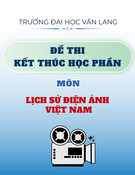
Thuật ngữ - ký hiệu ống kính Tamron
TAMRON LENS GLOSSARY - TERMINOLOGY -
ABBREVIATIONS
Ống kính Tamron
AD (Anomalous Dispersion) - Chất liệu kính cho phép kiểm soát tốt hơn
hiện tượng sắc sai, giảm hiện tượng sắc sai và cho hình ảnh chất lượng hơn.
ASL (Aspherial) - Thấu kính (gần như) phẳng, có tác dụng chống cầu sai,
làm tăng độ chính xác của hình ảnh và tạo khả năng sản xuất các ống zoom tỷ lệ
lớn hơn.
BIM (Built-in Motor) - Mô-tơ gắn trong ống kính dành riêng cho thân máy
Nikon.

Di (Digitally Integrated Design) - Thiết kế tích hợp công nghệ số nhằm sản
xuất các thấu kính / ống kính phù hợp với máy ảnh số. Các thân máy cảm bién cúp
nhỏ (APS-C) cũng có thể sử dụng ống Di nhưng sẽ có một số hiệu ứng khác với
khi lắp trên máy toàn khổ như hiện tượng tối mép ảnh giảm, boke giảm, v.v…
Di II (Digitally Integrated Design II) - Thiết kế tích hợp công nghệ số 2.
Các ống Di II phù hợp với máy ảnh số DSLR có cảm biến cúp nhỏ APS-C.
IF (Internal Focus) - Hệ thống căn nét trong với các thấu kính chuyển động
bên trong thân ống.
LD (Low Dispersion) - Chất liệu kính cao cấp làm thấu kính có độ tán xạ
thấp, giảm thiểu hiện tượng tán xạ làm tăng chất lượng hình ảnh.
SP (Super Performance Series) - Dòng ống kính có hiệu năng siêu việt, chất
lượng cao, cho hình ảnh đẹp.
USD (Ultrasonic Silent Drive) - Cơ chế căn nét tự động gắn mô-tơ siêu êm
không phát ra tiếng động và căn nét chính xác.
VC (Vibration Compensation) - Thuật ngữ Tamron sử dụng chỉ các ống
kính có gắn hệ thống chống rung, làm giảm tác động của hiện tượng rung tay máy.
XLD (Extra Low Dispersion) - Chất liệu kính cao cấp làm thấu kính có độ
tán xạ siêu thấp, tăng cường chất lượng hình ảnh.

XR (Extra Refractive Index) - Thủy tinh chiết xuất cao, có khả năng “bẻ”
các tia sáng ở góc hẹp hơn giúp sản xuất ống kính có chiều dài ngắn hơn đồng thời
giảm cầu sai.
ZL (Zoom Lock) - Ống kính có lẫy khóa chống tụt ống zoom khi mang đi
mang lại. Đặc biệt cần thiết khi ống đã sử dụng nhiều.
VinaCamera.com
2008-2010

ENGLISH
Di - Digitally Integrated Design
Di is a Tamron designation that applies to lenses that have been optimised
for digital capture using advanced multi-coating techniques and optical designs
that assure excellent image quality across the entire picture field. Because of these
characteristics, Di lenses provide outstanding performance on cameras with full-
frame and APS-C format sensors as well as on 35mm film.
Di II - Digitally Integrated Design for DSLRs with small sensors
Di II lenses are designed for exclusive use on digital SLR cameras with
APS-C-format image sensors. All Di II lenses are optimised to meet the
performance characteristics of DSLRs, providing maximal resolution concentrated
within the image field and assuring that light rays at the edges of the frame reach
the sensor at favourable angles, thereby minimising peripheral light falloff.
In addition, all Di II lenses incorporate effective measures to increase light
transmission and eliminate ghosting and flare, which are particularly noticeable
with digital cameras. Tamron’s advanced multi-coatings are applied not only to
external and internal lens surfaces, but also to surfaces in between cemented lens
elements. Finally, Di II lenses are offered in a wide array that includes the focal
length ranges most desired by DSLR shooters.

XR - Extra Refractive Index
XR (Extra Refractive Index) glass can bend light rays at steeper angles,
thereby decreasing the physical length of the lens while enhancing imaging
performance by minimising optical aberrations. This has allowed Tamron to
develop a line of shorter, smaller-diameter, lighter lenses without sacrificing lens
speed, actually upgrading image quality compared to older designs.
XR glass is costlier than conventional glass but it yields enhanced optical
power distribution, making possible many of the outstanding and innovative lens
designs that bear the XR designation.
SP - Super Performance series
Tamron SP (Super Performance) series is a line of ultra-high-performance
lenses designed and manufactured to the exacting specifications demanded by
professionals and others who require the highest possible image quality. In
creating SP lenses Tamron’s optical designers put their foremost priority on
achieving superior performance parameters – they are all designed to a higher
standard with little regard for cost constraints. As a result, Tamron lenses bearing
the SP designation feature impressive and innovative designs that have established
an enviable reputation for excellence among those knowledgeable photographers
that demand the very best.


![Đề cương ôn tập Bản đồ du lịch [năm hiện tại]](https://cdn.tailieu.vn/images/document/thumbnail/2025/20250809/dlam2820@gmail.com/135x160/53061754884441.jpg)




















![Câu hỏi ôn tập Kỹ thuật quay phim và chụp ảnh [chuẩn nhất]](https://cdn.tailieu.vn/images/document/thumbnail/2025/20250711/kimphuong1001/135x160/488_cau-hoi-on-tap-ky-thuat-quay-phim-va-chup-anh.jpg)


